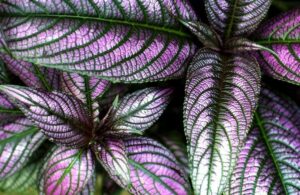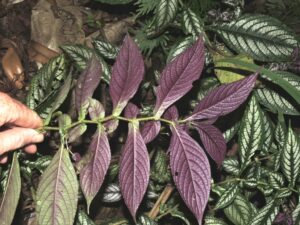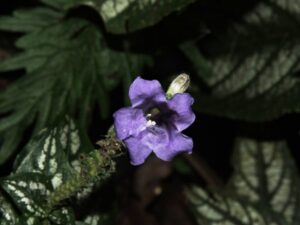Strobilanthes Auriculata Var. Dyeriana (Persian Shield)
go.ncsu.edu/readext?1073192
en Español / em Português
El inglés es el idioma de control de esta página. En la medida en que haya algún conflicto entre la traducción al inglés y la traducción, el inglés prevalece.
Al hacer clic en el enlace de traducción se activa un servicio de traducción gratuito para convertir la página al español. Al igual que con cualquier traducción por Internet, la conversión no es sensible al contexto y puede que no traduzca el texto en su significado original. NC State Extension no garantiza la exactitud del texto traducido. Por favor, tenga en cuenta que algunas aplicaciones y/o servicios pueden no funcionar como se espera cuando se traducen.
Português
Inglês é o idioma de controle desta página. Na medida que haja algum conflito entre o texto original em Inglês e a tradução, o Inglês prevalece.
Ao clicar no link de tradução, um serviço gratuito de tradução será ativado para converter a página para o Português. Como em qualquer tradução pela internet, a conversão não é sensivel ao contexto e pode não ocorrer a tradução para o significado orginal. O serviço de Extensão da Carolina do Norte (NC State Extension) não garante a exatidão do texto traduzido. Por favor, observe que algumas funções ou serviços podem não funcionar como esperado após a tradução.
English
English is the controlling language of this page. To the extent there is any conflict between the English text and the translation, English controls.
Clicking on the translation link activates a free translation service to convert the page to Spanish. As with any Internet translation, the conversion is not context-sensitive and may not translate the text to its original meaning. NC State Extension does not guarantee the accuracy of the translated text. Please note that some applications and/or services may not function as expected when translated.
Collapse ▲Strobilanthes auriculata var. dyeriana (Persian Shield)
Article by Extension Master Gardener℠ volunteer Kathryn Copley
Persian Shield is grown for its showy foliage — deep purple, lilac and green overlaid with silvery highlights on older leaves, creating an unusual metallic or iridescent sheen on the upper surface. The lower leaf surface is a solid purple-maroon. Leaves are large — 1- to 3-in. wide and up to 7-in. long, and they develop the best color in hot conditions.
Persian Shield is a soft-stemmed, tropical, shrub or sub-shrub. It can be grown as a perennial in zones 8b and warmer. It is grown as an annual in locations that experience frost.
Persian Shield prefers soil high in organic matter with good drainage but also plenty of water. It prefers dappled sunlight (shade through the upper tree canopy all day) or partial shade (direct sunlight for only 2 to 6 hours). Persian shield languishes when the weather is cool but grows quickly under hot and humid conditions to form a large, bushy plant.
Cool temperatures and low lighting conditions can reduce the foliage color, giving the plant a sort of washed-out appearance. As the plant ages, it develops woody stems and can lose its brilliant color, so it is best to start with fresh plants or take cuttings annually to obtain the most ornamental foliage. To promote a more bushy appearance of this 3- to 4-ft.-tall and 2- to 3-ft.-wide plant, pinch back the stems.
This plant is typically propagated from leaf or stem cuttings, but it can also be grown from seed. Basal or soft-wood cuttings taken in early spring or summer root readily in water or moist medium. Cuttings can also be taken in late summer or early fall to bring inside to overwinter. When grown indoors, watch for red spider mites and fungus gnats.
Its growth habit is clumping/mounding/rounded and growth rate is rapid. It is useful as an accent plant, in a border, or in a mass planting. In design terms, its foliage pro-vides textural interest and its color is an excellent counter-point to variegated, lime-green or chartreuse-colored foliage and plants with pink, lavender, purple, yellow, or orange flowers. The silvery highlights on the leaves echo white flowers or white to silvery foliage, such as Lamb’s Ears and Dusty Miller. For a dramatic, tropical effect mix Persian Shield with Caladiums, Elephant Ears, and/or Cannas.
Although a flowering plant, it is not grown for its tiny flowers.
It is resistant to heat, humidity, and (particularly) powdery mildew. Persian shield is not favored by deer or rabbits.






